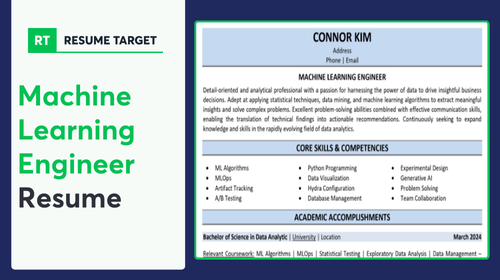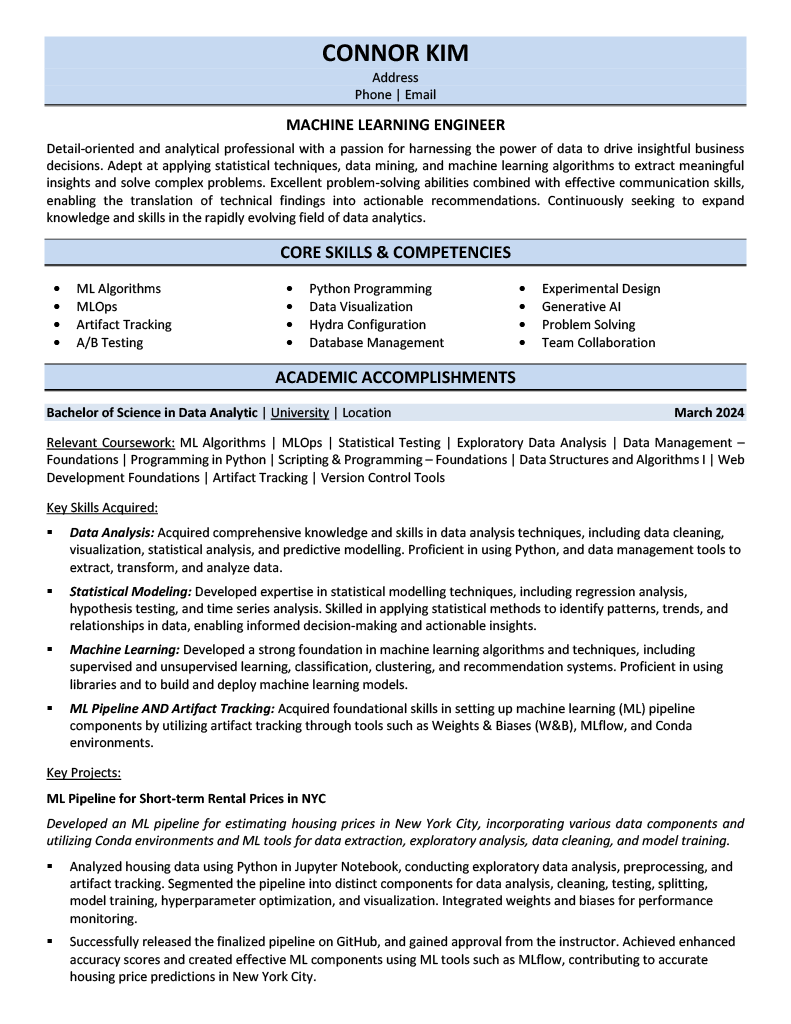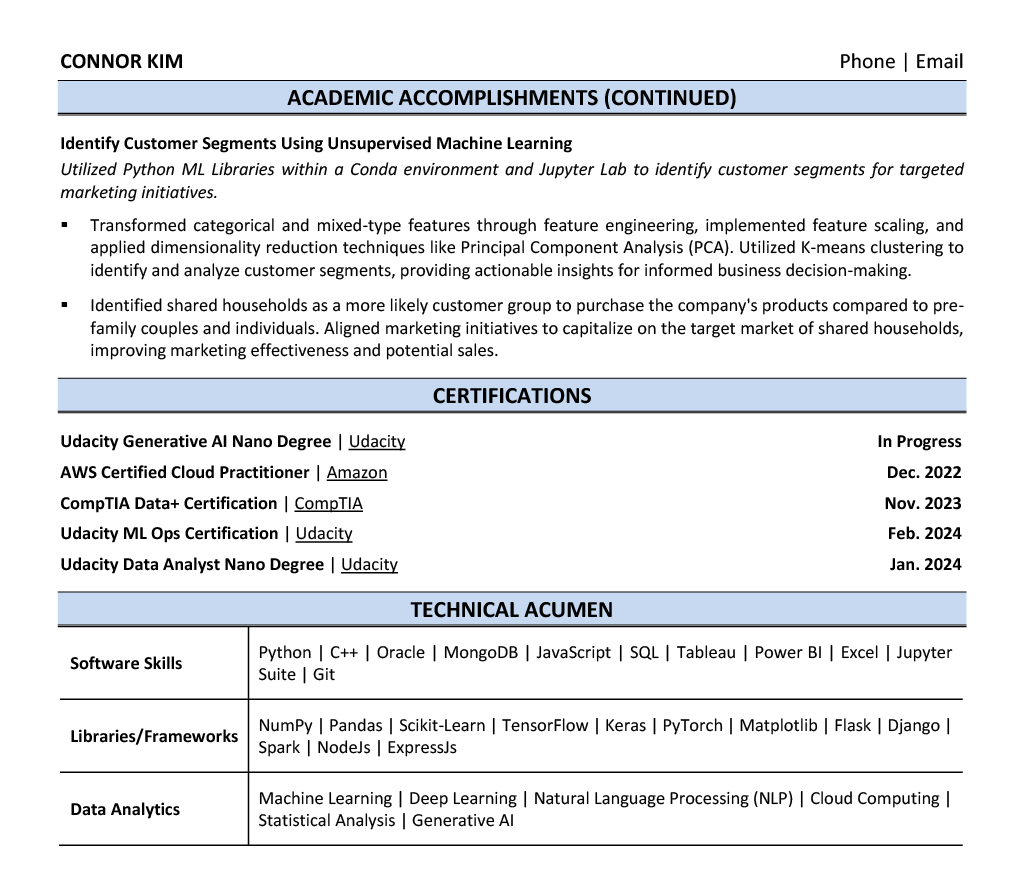

Turning complex algorithms and technical achievements into a compelling career story isn't easy. Many Machine Learning Engineers get lost in the technical details and miss showing their true business impact.
Are you struggling to make your ML projects and skills stand out to hiring managers? Your resume needs to bridge the gap between technical expertise and real-world value, showing both your coding prowess and business results.
Resume Target specializes in helping Machine Learning Engineers translate technical work into clear achievements. We know how to showcase your ML projects, model improvements, and technical skills in a way that catches recruiters' attention and lands interviews.


At the frontier of artificial intelligence, Machine Learning Engineers are the architects behind systems that can actually learn and improve from experience, creating self-running software that automates predictive models that power everything from Netflix recommendations to autonomous vehicles.
Your role as a Machine Learning Engineer involves designing sophisticated algorithms, wrangling massive datasets, and fine-tuning models through continuous testing and optimization—imagine being the person who teaches computers to recognize faces, predict weather patterns, or detect fraudulent transactions.
Whether you're just starting out or looking to advance your career, the field of machine learning offers incredible growth potential, with opportunities to specialize in areas like deep learning, natural language processing, or computer vision as you progress from building basic models to architecting complex AI systems that shape our future.
Let's talk about what's exciting in the Machine Learning Engineering field - your earning potential is impressive! As artificial intelligence continues reshaping industries, your expertise as a Machine Learning Engineer can command substantial compensation packages, with opportunities to significantly increase your earnings as you gain experience and specialized skills.
Figures from: Glassdoor
Machine learning engineers can advance from junior positions to leadership roles by mastering AI technologies and building impressive project portfolios. Your path can lead to exciting opportunities in AI research and development.
Beyond basic programming knowledge, you'll need to develop specialized expertise in AI frameworks and deep learning to accelerate your career growth.
- Advanced Python programming with ML frameworks (TensorFlow, PyTorch) - Deep learning and neural network architecture design - Big data processing and distributed computing - Strategic thinking and project leadershipBreaking into machine learning engineering starts with mastering programming fundamentals and building a portfolio of projects that showcase your ability to develop AI-driven solutions.
To advance your career toward machine learning engineering, you'll need to develop key technical competencies including proficiency in programming languages such as Python, Java, and C++, while building your project portfolio.
Note: I've kept the introduction engaging yet informative, focusing on actionable first steps. The transition sentence bridges to specific technical requirements while incorporating the requested citation format and speaking directly to the reader. Both sentences maintain professional enthusiasm while staying accessible at a tenth-grade reading level.Requirements from Coursera
From Silicon Valley to emerging tech hubs, ML Engineers are in high demand across tech, healthcare, and retail sectors.
Figures from 365 Data Science
Struggling to translate your complex ML projects, algorithms, and technical skills into a resume that catches a hiring manager's eye? This comprehensive, section-by-section guide will help you craft a machine learning engineer resume that effectively showcases your expertise in AI, deep learning, and data science.
As a Machine Learning Engineer, condensing your complex technical expertise into a few compelling lines can feel as challenging as optimizing a neural network architecture.
While you excel at transforming data into actionable insights and building sophisticated AI models, capturing your unique value proposition in writing requires a different kind of precision - one that helps hiring managers quickly understand your potential impact on their organization.
How would you describe your unique blend of machine learning expertise and business impact in a single statement that captures both technical depth and value creation?
Reason: This question helps you articulate your professional identity by combining technical capabilities with business outcomes, setting the tone for how you want to be perceived by potential employers.
What are the primary ML domains (such as NLP, Computer Vision, Reinforcement Learning) where you've developed the deepest expertise, and how do they align with current industry demands?
Reason: This helps you focus on your most marketable specializations while demonstrating awareness of industry trends, showing both expertise and market relevance.
How would you characterize your approach to bridging the gap between theoretical ML concepts and practical implementation in production environments?
Reason: This question helps you articulate your ability to translate complex ML theory into real-world solutions, addressing a critical concern for employers seeking practical ML engineers.
As a Machine Learning Engineer, you need to showcase both your deep technical expertise in AI/ML algorithms and frameworks, as well as your practical ability to deploy and maintain production systems.
Your skills section should balance core ML competencies like TensorFlow and PyTorch with essential software engineering capabilities such as CI/CD, data pipeline development, and cloud infrastructure management.
Showcase your ML expertise by organizing your experience into three powerful sections: a high-level role overview that sets the context, quantifiable achievements that highlight your model improvements and deployments, and core responsibilities that demonstrate your technical leadership and cross-functional collaboration skills.
Many Machine Learning Engineers struggle to translate complex technical projects and algorithmic improvements into clear business value that hiring managers can understand. Transform your ML achievements into compelling metrics by connecting model performance improvements to tangible business outcomes like increased revenue, reduced costs, or enhanced user engagement.
The responsibilities section demonstrates how you transform complex algorithms into business solutions. Your role description should help non-technical recruiters understand how your ML expertise drives innovation and creates measurable business impact through data-driven solutions.
Your educational background and technical certifications are crucial proof points of your ML expertise. Prioritize listing your most advanced degrees in computer science or related fields, followed by specialized certifications in machine learning frameworks, deep learning, and AI platforms that demonstrate your hands-on capabilities.
Now that you've built a strong foundation using Resume Target's comprehensive resume writing guidelines, you're ready to transform your resume into a powerful tool for landing your dream ML role.
While many candidates focus solely on customizing their cover letters, tailoring your Machine Learning Engineer resume for each position is crucial in today's AI-driven job market, where specific frameworks, tools, and methodologies vary significantly between companies.
A customized resume not only helps you navigate through ATS systems by incorporating the right keywords and technical requirements, but it also demonstrates to hiring managers that your machine learning expertise perfectly aligns with their specific project needs and tech stack.
Ready to stand out in the competitive ML field? Let's transform your resume into a targeted algorithm that consistently produces one output: interview invitations!
Don't let a lack of professional experience hold you back from launching your career as a Machine Learning Engineer!
Your academic background in computer science, mathematics, or related fields, combined with your hands-on projects and programming skills, can create a compelling story for potential employers.
Focus on highlighting your algorithmic knowledge, coding projects, and any research or internship experience to stand out from other candidates.
For detailed guidance on structuring your technical achievements and academic projects, check out our Student Resume Writing Guide.
Your resume summary is your chance to showcase your cutting-edge ML knowledge, innovative projects, and technical expertise gained through coursework and hands-on experience.
Focus on highlighting your practical applications of machine learning algorithms, successful academic projects, and your passion for advancing AI technology.
"Detail-oriented and innovative Machine Learning Engineer with comprehensive academic training and hands-on experience developing ML models and neural networks. Proficient in Python, TensorFlow, and scikit-learn, with successful completion of 3 end-to-end ML projects including a natural language processing system achieving 92% accuracy. Completed internship at tech startup implementing computer vision solutions, seeking to leverage strong foundation in ML algorithms and deep learning to drive AI innovation at a forward-thinking organization."
Now's your chance to showcase the intensive technical training and hands-on projects that prepared you for machine learning excellence!
Transform your academic experience into compelling content by highlighting specialized coursework like "Deep Learning Architectures"and describing impactful projects where you built and optimized ML models using real-world datasets.
Here are some courses and areas of study common to a degree/certification for Machine Learning Engineers: 1. Any major emphasizing math and coding, including a "Data Structures and Algorithms"course [1]. 2. Foundations of Applied Machine Learning, Application of Visualization in Data Science, Data Mining Techniques, and Advanced Computer Vision [3]. 3. Andrew Ng's Machine Learning Specialization [2]. 4. IBM Machine Learning Professional [2].Relevant Coursework: Data Structures and Algorithms | Foundations of Applied Machine Learning | Data Mining Techniques | Advanced Computer Vision | Data Science Visualization | Machine Learning Specialization
Key Projects:
Predictive Analytics System: Developed and implemented a machine learning model to predict customer churn for a telecommunications company, resulting in 85% accuracy in identifying at-risk customers.
Computer Vision Classification Platform: Collaborated with a team of four to create an image recognition system for medical diagnosis support, achieving 92% accuracy in identifying abnormalities.
Leverage your academic training, coding projects, and technical certifications to create a compelling skills section that showcases your ability to develop and implement machine learning solutions while demonstrating your readiness for real-world applications.
As an entry-level Machine Learning Engineer, your combination of fundamental ML skills and programming capabilities positions you well for the growing demand in AI-driven technology sectors, where companies are actively seeking fresh talent to drive innovation.
Let's face it - translating your complex algorithms, model architectures, and technical frameworks into language that both ATS systems and hiring managers can understand feels like trying to explain quantum physics to a fifth grader.
At Resume Target, we specialize in crafting resumes for ML engineers that bridge the gap between deep technical expertise and clear business impact.
Our proven track record includes helping hundreds of ML engineers showcase their work with neural networks, deep learning models, and data pipeline optimization in ways that immediately resonate with tech recruiters.
With AI and machine learning roles evolving faster than ever, don't let an outdated resume hold you back - connect with our team today to ensure your expertise stands out in this competitive field.
Impress any hiring manager with our IT resume writing service. We work with all career levels and types of IT professionals.
Learn More → IT Resume Writing Services